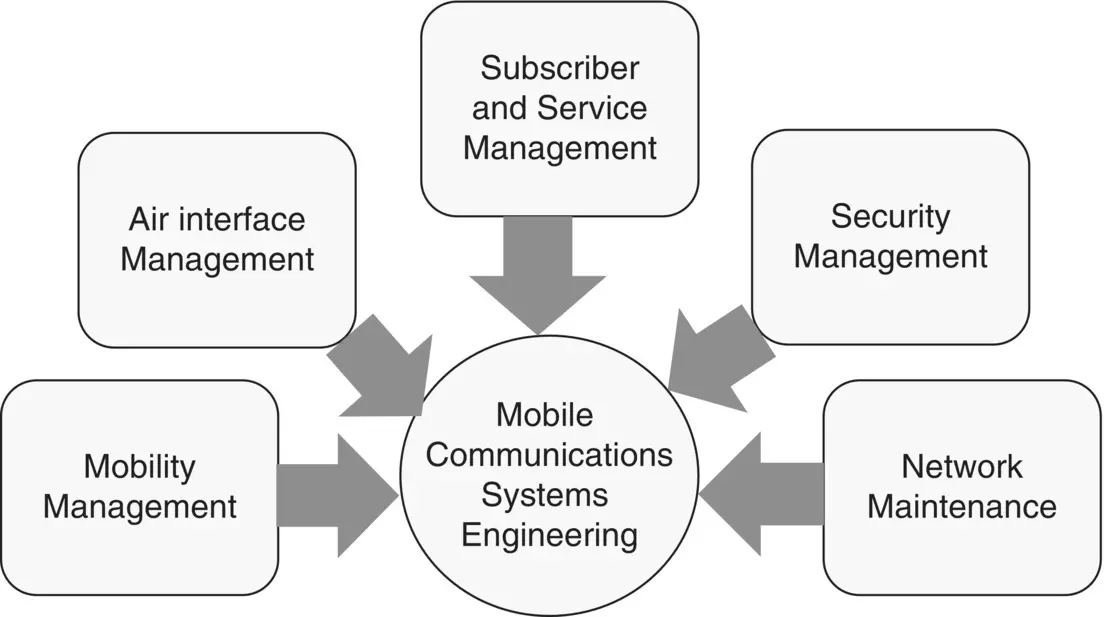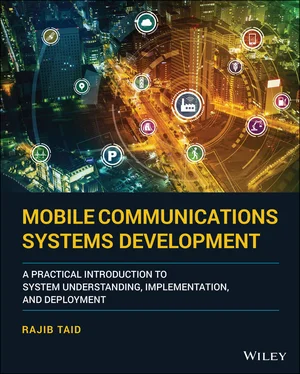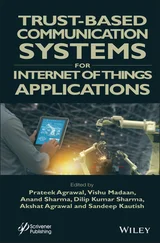The network architecture of the Release 8 or the first version of the LTE system was shown earlier in Figure 2.4. From a comparative study of network architectures of the GSM, GPRS, UMTS, and LTE systems, the following characteristics of the Release 8, i.e. first version of the LTE network, can be summarized.
A simpler and fully PS network based on IP transport, from E‐UTRAN to Evolved Packet Core (EPC). The CS domain is no longer available in the LTE and EPC networks.
Both the AN and the CN domains of the LTE system has evolved, from the previous UMTS system, due to which it is also known as the System Architecture Evolution (SAE).
LTE/EPC network has a flat architecture with fewer nodes or network elements, resulting in reduced latency and faster exchanges of information between UEs and E‐UTRAN. This is because unlike the GSM and UMTS, there is no separate radio controller in the LTE system. Radio controller functionalities are integrated into the eNodeB, and it alone performs the similar functions performed by a GSM BSC and BTS or UMTS RNC and NodeB.
New EPC network elements – MME, S‐GW, and PDN gateway – have been added.
Another version of the LTE system architecture is shown in Figure 2.13. Unlike Figure 2.4, the following figure shows the interconnection of the Evolved Packet Core Network elements also, namely, the S‐GW, the PDN gateway, and the HSS.
The S‐GW handles and performs the user data transfer‐related function, e.g. packet forwarding and routing, of the EPC network. A PDN gateway, similar to the GGSN of a GPRS network, allocates an IP address to a UE and connects the EPC network to the external IP network. For an overview of the functions by these network elements, refer to TS 23.002 [29]. The EPC network in the 3GPP Release 8 architecture support PS services only. To provide a CS voice call service for a UE registered in an LTE/EPC network, alternate features are used such as the Circuit Switched Fall Back (CSFB) and IMS. More about the IMS and CSFB features are described in later Sections 6.2.1.1and 6.2.3.

Figure 2.13 LTE system architecture with EPC nodes.
2.4 Mobile Communications Network System Engineering
In Section 2.2, the network domains of a typical mobile communications network have been introduced. Apart from these, there are several other aspects of a mobile communications network that enable network operators to run their network smoothly. Similar to any other systems engineering, a mobile communications network is also an interdisciplinary system that provides various management functions in realizing a successful network while enabling and offering various communications services to subscribers. At a high level, the essential and general systems engineering aspect of each of the mobile communications systems and networks based on the GSM, UMTS, LTE, and 5G systems can be divided into different management areas, as shown in Figure 2.14. These system engineering aspects span across the AN, the core network, and beyond.
2.4.1 Mobility Management
Mobility management aspects of a system engineering deals with the capabilities and functions performed by a mobile communications network for enabling the continuation of the current communication services being in use by a moving user. It also deals with keeping track of the current location of a mobile user so that the network could reach and alert the mobile device for an incoming call at any point in time. Other situations where mobility management functions are needed are as follows:

Figure 2.14 Mobile communications network systems engineering.
Whenever a mobile device is switched off and on again in the same area or different service areas.
The current state of the mobile device, i.e. idle and active and their transition.
5G system mobility management system engineering aspects are described later in Chapter 18.
2.4.2 Air Interface Management
In a mobile communications network, the air interface is used to transmit and receive data, i.e. signaling and voice traffic, over a wireless medium between a mobile device and its base trans‐receiver station. The air interface uses the radio frequency transmission and forms the basis for the physical layer between the mobile device and the base trans‐receiver station. Air interface management deals with the optimum allocation, re‐assignment, and releasing of the allocated radio frequency resources in terms of timeslots/channels among the mobile devices. The physical properties and structure of the air interface greatly differentiate one system from another one, i.e. TDMA/FDMA in GSM, WCDMA in UMTS, and OFDMA/SCDMA in the case of the LTE system. In Section 2.3.1, we discussed how the air interface evolved from the GSM to LTE. 5G system air interface management aspects are described in Chapter 19.
2.4.3 Subscribers and Services Management
Subscribers and services management deals with various administrative tasks, as follows:
Subscriber provisioning, i.e. establishes a new subscription, edits, or updates the existing tariff plan details, such as the supplementary services and value‐added services, subscribed by a subscriber.
Stores subscriber information in a central database.
Generates charging, billing, and accounting for subscribers.
2.4.4 Security Management
Protecting the user’s identity while engaging in a mobile communications service is a prime concern. As far as the security management functions are concerned, a mobile communications network provides the following facilities:
Authentication, which ensures that only an authorized user/subscriber access mobile communications network services.
Subscriber information confidentiality through ciphering/encryption method.
Allocation of temporary identity to a mobile device to protect user identity.
Security Management aspects are described in Chapter 9.
2.4.5 Network Maintenance
Apart from network elements and their software systems, a mobile communications network consists of various active and passive infrastructures and devices. Network faults cannot be ruled out during the peak load time. Periodic and preventive maintenance minimizes the chances of failures and network downtime. Various tools are used for fault detection as well as correction of network faults. Network management aspects are described in Chapters 10– 12.
Each system engineering area that is shown in Figure 2.14is further divided into different subject areas, such as requirements, design, and signaling. The implementation details of each of the management areas shown in Figure 2.14shall differ as defined by the concerned 3GPP TSs, from the GSM to the 5G system. For example, in the case of the GSM system, ciphering and encryption are done for messages exchanged between the MS and the RAN only, whereas in the case of the LTE or 5G system, ciphering is also done for messages exchanged between the MS and the core network element. Also, the implementation details of a particular management area mentioned in Figure 2.14may differ in the case of CS and PS call. For example, in the GSM system, ciphering is performed by the BTS, whereas in the GPRS system, the same is performed by the SGSN.
In this book, only the Mobility Management, Air Interface Management, Security Management, and the Network Management system engineering areas are covered. The interested reader is recommended to look for other resources for the subscribers and services management area of a particular mobile communications network.
Читать дальше














